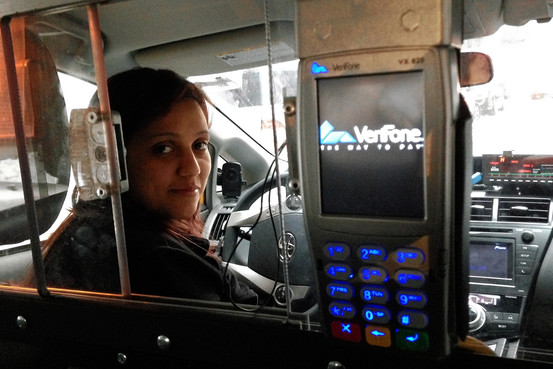
After my wife expresses relief that we’ve gotten home safely when the wheels of our plane touch down at JFK or La Guardia, I remind her that possibly the most dangerous part of our journey—the cab ride back into Manhattan—is yet to come.
Trans-Atlantic turbulence is nothing compared to some of the cab rides I’ve taken. You often find yourself clutching the armrest or anything else you can grab as your cabby careens in and out of traffic on the Grand Central Parkway. Or else you catch sight of him dozing off as he nears the end of his 12-hour shift.
For that reason, I’ve grown to appreciate uneventful rides, such as the one I experienced Sunday afternoon from JFK. My driver, Navjot Singh, navigated the traffic with just the right mix of caution and aggression.

Dozens of taxis make their way though Times Square in New York. Reuters
Was it any coincidence that the cabby happened to be a woman? There have been female cabdrivers for as long as I can remember—but not many of them. Of New York City’s 51,350 cabdrivers, only 552, or just more than 1%, are women, according to Taxi & Limousine Commission spokesman Allan Fromberg.
But as I sat in her back seat, I wondered, as blasphemous as it may sound to some, whether women might actually make better cabdrivers than men. Whether they might be less prone to conditions such as road rage, for example.
« We can drive like a man, » Ms. Singh said. « We can be aggressive like a man. » But at the same time, she added, women can be « softer and faster. »
By that, I believe she meant that for women, there may be no shame in yielding occasionally to your fellow motorist, and that they may not take it as a personal affront to their manhood, or rather womanhood, when someone cuts in front of them.
Ms. Singh, who is 25, grew up in Germany with an Indian father and a Yugoslavian mother. She told me she’s been driving a cab for three years. She started after her husband, a general contractor, suffered an accident that made it difficult for him to work. She hopes one day to become a physical therapist.
Some members of her extended Indian family balked at the idea of her driving a cab, she said, believing it « shameful » for a woman to do so. « My husband said, ‘Sometimes we have bad times. Men are doing it. Why can’t the women do it?' »
She likes the hours, usually working nights because that leaves the days to raise her two daughters, ages 5 and 3. « A man can go home—sleep and work, » she explained. « I have to take them to school and to the doctor. »
She said this by way of explaining why she earns less than a male driver—$1,500 to $1,700 a week, compared with the $2,200 or more she estimates male drivers make—though she suspects that passengers give her better tips because she’s a woman.
« Some people are really nice; they’re really respectful, » she said, impressed because she’s mastered the city’s mean streets. « They’re giving a feeling that I’m in the right way, that I don’t have to stay home. »
Certain elements of the taxi industry may not agree. Ms. Singh said that when she first tried to find work, cab owners balked at hiring her. « They think women are bad drivers, » she said.
Instead, she bought a cab that a relative of hers was driving under a leased medallion. Ms. Singh attributes her work ethic to her mother. « She always says, ‘I don’t want to depend on somebody.' »
On Sunday, her shift started around 2 p.m. But her day started early that morning at her Queens temple, where she said she has a food stand, paying out of her own pocket to feed parishioners and visitors. « We want the people should come with their kids and have good society, » she explained. « Nobody is telling me. I do it because I feel it’s for a good thing. »
She added that her faith has seen her through both good times and bad: « I get good help from God. »
Her best tip as a cabby came when a New Year’s Eve passenger witnessed her perform an act of kindness. A beggar was going from car to car at a stoplight when Ms. Singh placed $8 in his cup. « The person gave me $80. I said, ‘You pressed the wrong button.’ He said, ‘I didn’t.' »
The hardest part of her job, especially working nights and weekends, is dealing with obnoxious drunks, such as the one she picked up a few months ago at 68th and Lexington Avenue. He wanted to be taken to the Bronx, passed out in the back of her cab and refused to pay when he eventually regained consciousness.
Perhaps even worse are drunks who get sick in the back of her cab. « What most cabbies do is they put seltzer water down and vacuum it up, » Ms. Singh said.
But she has an even more effective method to handle the mess and get rid of the odor. « I take the cab home and let my husband do it, » she said with a laugh. « I open the windows—I have deodorant here. But as soon as possible I’ll go home. I’ll say to my husband, ‘You have to do it.' »
Source : The Wall Street Journal
